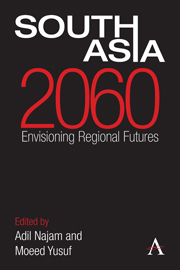Book contents
- Frontmatter
- Contents
- Acknowledgments
- List of Abbreviations
- Introduction: Imagining South Asian Futures
- Section I South Asia as a Region
- Section II State Relations
- Section III Development
- Chapter 16 South Asian Economy in 2060
- Chapter 17 Economic Futures: Challenges Ahead
- Chapter 18 South Asia in the Asian Economy: Struggling to Overcome History
- Chapter 19 Globalization and South Asia
- Chapter 20 Trade Relations: Some Predictions and Lessons
- Chapter 21 Urban Policy for Environmental Quality and Well-Being
- Chapter 22 Urban Futures, Urban Challenges
- Chapter 23 Water Security: Risks and Responses
- Chapter 24 Agriculture and Food Security
- Chapter 25 Meeting Electric Power Demand in South Asia
- Chapter 26 E-South Asia: A Social Science Fiction
- Section IV Human Well-Being
- About the Authors
- Bibliography
- Index
Chapter 24 - Agriculture and Food Security
from Section III - Development
Published online by Cambridge University Press: 05 September 2013
- Frontmatter
- Contents
- Acknowledgments
- List of Abbreviations
- Introduction: Imagining South Asian Futures
- Section I South Asia as a Region
- Section II State Relations
- Section III Development
- Chapter 16 South Asian Economy in 2060
- Chapter 17 Economic Futures: Challenges Ahead
- Chapter 18 South Asia in the Asian Economy: Struggling to Overcome History
- Chapter 19 Globalization and South Asia
- Chapter 20 Trade Relations: Some Predictions and Lessons
- Chapter 21 Urban Policy for Environmental Quality and Well-Being
- Chapter 22 Urban Futures, Urban Challenges
- Chapter 23 Water Security: Risks and Responses
- Chapter 24 Agriculture and Food Security
- Chapter 25 Meeting Electric Power Demand in South Asia
- Chapter 26 E-South Asia: A Social Science Fiction
- Section IV Human Well-Being
- About the Authors
- Bibliography
- Index
Summary
South Asia, with a population of 1.7 billion, is the second most populated region of the world, after East Asia. Nearly half of the world's poor live in this region. It is one of the fastest growing regions, registering an average gross domestic product (GDP) growth rate of 6 percent per annum over the last two decades (1990–2010). Yet, it is also the least integrated region with high incidence of cross-border conflicts and vulnerability to internal and external shocks, climate change and natural disasters (e.g., floods, droughts, cyclones, etc.).
Agriculture (including crops, livestock, poultry and fisheries) continues to be a vital sector of the economies of the South Asian region despite significant structural change over the past two decades. Agriculture is still the main source of livelihood for 75 percent of its population that lives in the rural areas; it constitutes about 21 percent of the GDP and employs about 42 percent of the labor force of the region. The regional picture however masks the significant differences in the size and structure of the South Asian economies as reflected in Table 1.
For instance, India, Pakistan, Bangladesh and Sri Lanka with agriculture value added ranging between 12 to 38 percent of total GDP are transforming at a relatively rapid pace from agro-based to transforming economies, while Afghanistan, Bhutan, Maldives and Nepal with agriculture value added about 40 percent or more are still primarily agro-based.
- Type
- Chapter
- Information
- South Asia 2060Envisioning Regional Futures, pp. 183 - 191Publisher: Anthem PressPrint publication year: 2013



